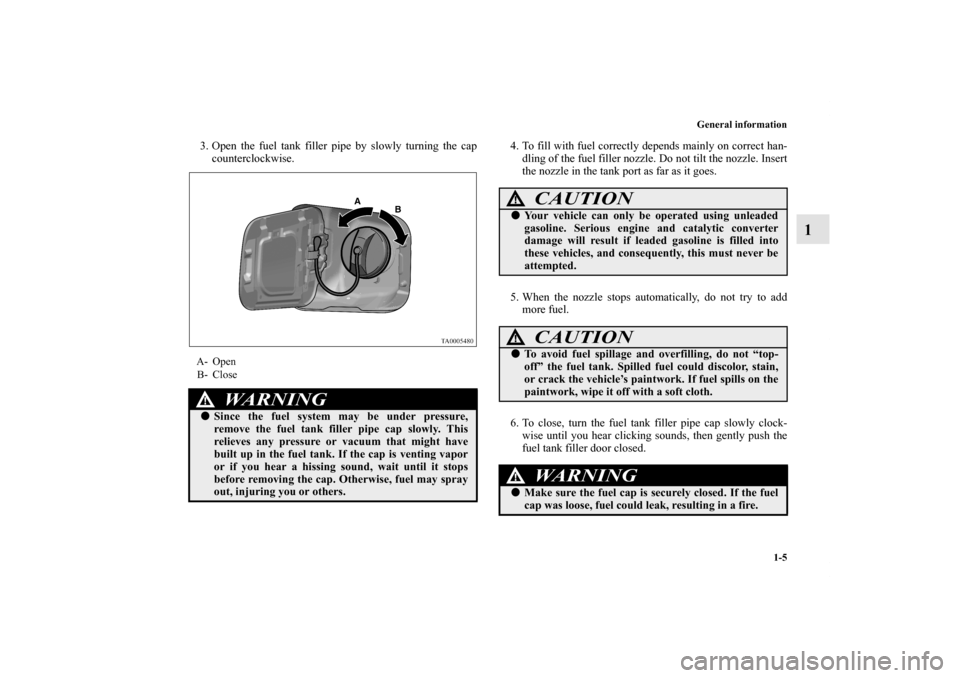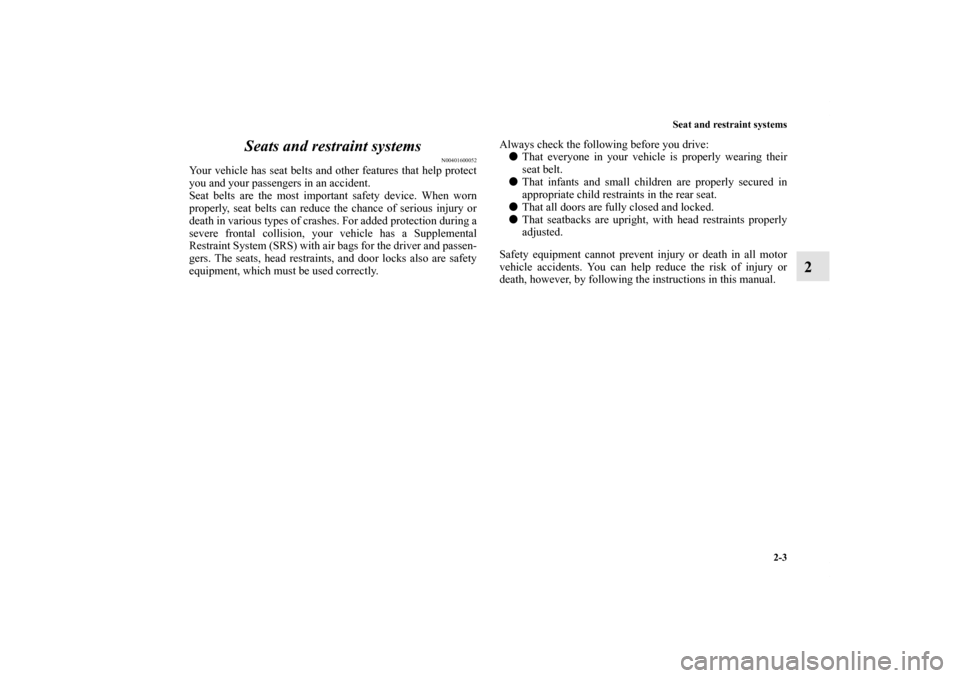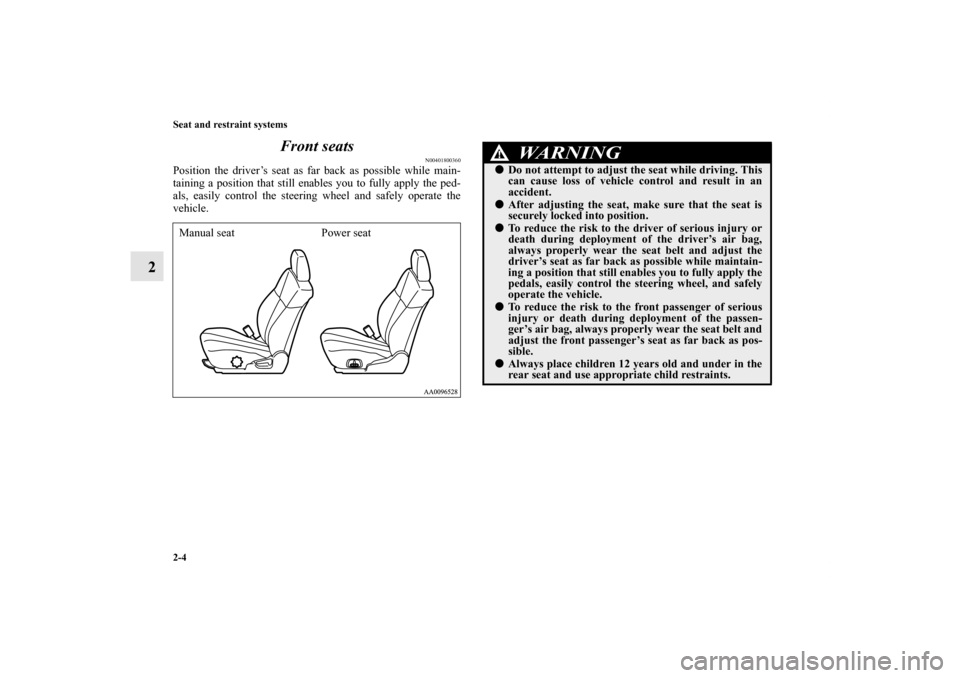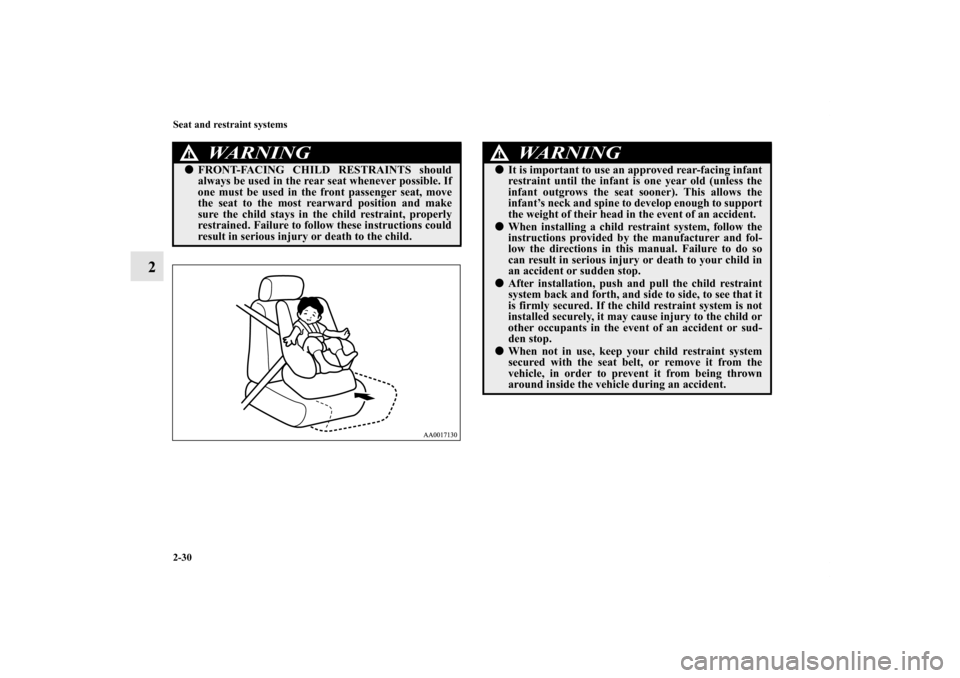Page 22 of 424

General information
1-5
1
3. Open the fuel tank filler pipe by slowly turning the cap
counterclockwise.4. To fill with fuel correctly depends mainly on correct han-
dling of the fuel filler nozzle. Do not tilt the nozzle. Insert
the nozzle in the tank port as far as it goes.
5. When the nozzle stops automatically, do not try to add
more fuel.
6. To close, turn the fuel tank filler pipe cap slowly clock-
wise until you hear clicking sounds, then gently push the
fuel tank filler door closed.A- Open
B- Close
WA R N I N G
!�Since the fuel system may be under pressure,
remove the fuel tank filler pipe cap slowly. This
relieves any pressure or vacuum that might have
built up in the fuel tank. If the cap is venting vapor
or if you hear a hissing sound, wait until it stops
before removing the cap. Otherwise, fuel may spray
out, injuring you or others.
CAUTION
!�Your vehicle can only be operated using unleaded
gasoline. Serious engine and catalytic converter
damage will result if leaded gasoline is filled into
these vehicles, and consequently, this must never be
attempted.
CAUTION
!�To avoid fuel spillage and overfilling, do not “top-
off” the fuel tank. Spilled fuel could discolor, stain,
or crack the vehicle’s paintwork. If fuel spills on the
paintwork, wipe it off with a soft cloth.
WA R N I N G
!�Make sure the fuel cap is securely closed. If the fuel
cap was loose, fuel could leak, resulting in a fire.
BK0121200US.book 5 ページ 2010年4月14日 水曜日 午前11時24分
Page 30 of 424

Seat and restraint systems
2-3
2 Seats and restraint systems
N00401600052
Your vehicle has seat belts and other features that help protect
you and your passengers in an accident.
Seat belts are the most important safety device. When worn
properly, seat belts can reduce the chance of serious injury or
death in various types of crashes. For added protection during a
severe frontal collision, your vehicle has a Supplemental
Restraint System (SRS) with air bags for the driver and passen-
gers. The seats, head restraints, and door locks also are safety
equipment, which must be used correctly.Always check the following before you drive:
�That everyone in your vehicle is properly wearing their
seat belt.
�That infants and small children are properly secured in
appropriate child restraints in the rear seat.
�That all doors are fully closed and locked.
�That seatbacks are upright, with head restraints properly
adjusted.
Safety equipment cannot prevent injury or death in all motor
vehicle accidents. You can help reduce the risk of injury or
death, however, by following the instructions in this manual.
BK0121200US.book 3 ページ 2010年4月14日 水曜日 午前11時24分
Page 31 of 424

2-4 Seat and restraint systems
2Front seats
N00401800360
Position the driver’s seat as far back as possible while main-
taining a position that still enables you to fully apply the ped-
als, easily control the steering wheel and safely operate the
vehicle.
Power seat Manual seat
WA R N I N G
!�Do not attempt to adjust the seat while driving. This
can cause loss of vehicle control and result in an
accident. �After adjusting the seat, make sure that the seat is
securely locked into position.�To reduce the risk to the driver of serious injury or
death during deployment of the driver’s air bag,
always properly wear the seat belt and adjust the
driver’s seat as far back as possible while maintain-
ing a position that still enables you to fully apply the
pedals, easily control the steering wheel, and safely
operate the vehicle.�To reduce the risk to the front passenger of serious
injury or death during deployment of the passen-
ger’s air bag, always properly wear the seat belt and
adjust the front passenger’s seat as far back as pos-
sible. �Always place children 12 years old and under in the
rear seat and use appropriate child restraints.
BK0121200US.book 4 ページ 2010年4月14日 水曜日 午前11時24分
Page 32 of 424
Seat and restraint systems
2-5
2
To adjust the seat forward or backward
N00401900299
Manual seatPull the seat adjusting lever up and slide the seat forward or
backward to the desired position. Release the adjusting lever to
lock the seat in place.
CAUTION
!�Make sure that the seat is adjusted by an adult. If it
is adjusted by a child, an unexpected accident might
occur.�Do not place a cushion or the like between your back
and the seatback while driving. The effectiveness of
the head restraints will be reduced in the event of an
accident.�When sliding the seats, be careful not to catch your
hand or leg.�When sliding or reclining the seat rearward, pay
careful attention to the rear seat passengers.
WA R N I N G
!�To make sure that the seat is securely locked, try to
move it forward or backward without using the
adjusting lever.
BK0121200US.book 5 ページ 2010年4月14日 水曜日 午前11時24分
Page 46 of 424
Seat and restraint systems
2-19
2
3. Pull the seat belt out slowly while holding the latch plate.
Push the latch plate into the buckle until you hear a
“click”. Pull up on the belt to be sure the latch plate is
locked securely in the buckle.NOTE�If the seat belt locks up and cannot be pulled out, pull it
once with force and let it retract all the way.
Then, pull the belt out slowly once again.4. The lap part of the belt must always be worn low and snug
across the hips. Pull up on the shoulder portion of the belt
to take up any slack in the lap belt.
BK0121200US.book 19 ページ 2010年4月14日 水曜日 午前11時24分
Page 48 of 424
Seat and restraint systems
2-21
2
Front passenger seat belt warning light
N00418300035
The front passenger seat belt warning light is located above the
central vents in the instrument panel.
The light normally comes on when the ignition switch is turned
to the “ON” position and goes off a few seconds later.
The light comes on when a person sits on the front passenger
seat but does not fasten the seat belt. It goes off when the seat
belt is subsequently fastened.
WA R N I N G
!�In order to reduce the risk of serious injury or death
in an accident, always wear your own seat belt. Do
not allow anyone to ride in your vehicle unless he or
she is also seated and wearing a seat belt. Children
should additionally be restrained in a secure child
restraint system.
WA R N I N G
!�Do not install any accessory or sticker that makes
the light difficult to see.
BK0121200US.book 21 ページ 2010年4月14日 水曜日 午前11時24分
Page 49 of 424
2-22 Seat and restraint systems
2
Adjustable seat belt shoulder anchor (front seats)
N00406300083
To move the anchor down, press the lock knob (A) and slide
the anchor down to the desired position.
To move the anchor up, slide the anchor up to the desired posi-
tion.Anchor down Anchor up
WA R N I N G
!�Always adjust the shoulder belt anchor so that the
shoulder belt is positioned across the center of your
shoulder without touching your neck. The shoulder
belt should not be able to fall off your shoulder. Fail-
ure to follow this instruction can adversely affect
seat belt performance and increase the risk of seri-
ous injury or death in the event of an accident.�Adjust the shoulder belt anchor only when the vehi-
cle is not in motion.�Make sure the anchor is securely locked in position
after adjusting it.
BK0121200US.book 22 ページ 2010年4月14日 水曜日 午前11時24分
Page 57 of 424

2-30 Seat and restraint systems
2
WA R N I N G
!�FRONT-FACING CHILD RESTRAINTS should
always be used in the rear seat whenever possible. If
one must be used in the front passenger seat, move
the seat to the most rearward position and make
sure the child stays in the child restraint, properly
restrained. Failure to follow these instructions could
result in serious injury or death to the child.
WA R N I N G
!�It is important to use an approved rear-facing infant
restraint until the infant is one year old (unless the
infant outgrows the seat sooner). This allows the
infant’s neck and spine to develop enough to support
the weight of their head in the event of an accident. �When installing a child restraint system, follow the
instructions provided by the manufacturer and fol-
low the directions in this manual. Failure to do so
can result in serious injury or death to your child in
an accident or sudden stop. �After installation, push and pull the child restraint
system back and forth, and side to side, to see that it
is firmly secured. If the child restraint system is not
installed securely, it may cause injury to the child or
other occupants in the event of an accident or sud-
den stop. �When not in use, keep your child restraint system
secured with the seat belt, or remove it from the
vehicle, in order to prevent it from being thrown
around inside the vehicle during an accident.
BK0121200US.book 30 ページ 2010年4月14日 水曜日 午前11時24分